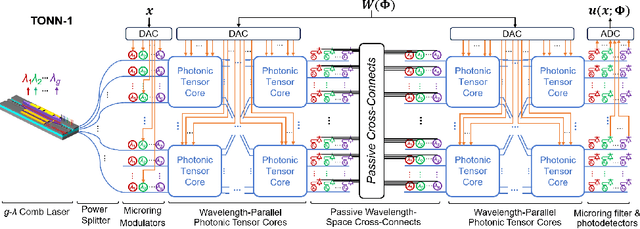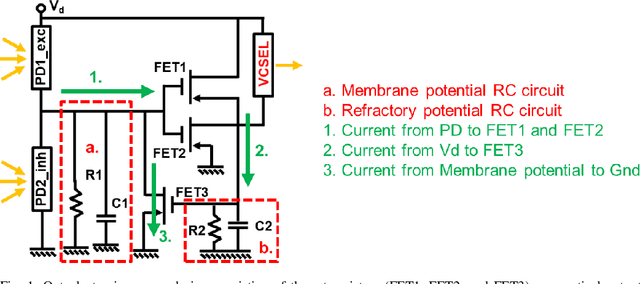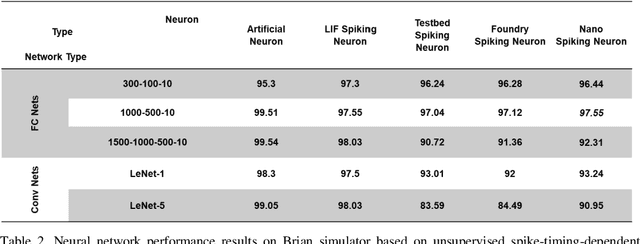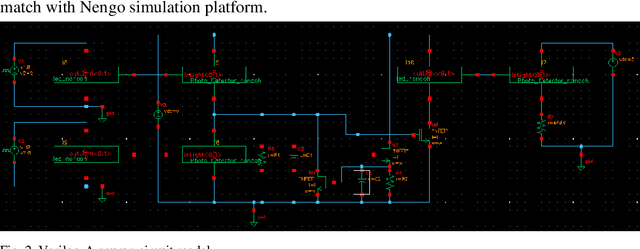Xian Xiao
Scalable Back-Propagation-Free Training of Optical Physics-Informed Neural Networks
Feb 17, 2025Abstract:Physics-informed neural networks (PINNs) have shown promise in solving partial differential equations (PDEs), with growing interest in their energy-efficient, real-time training on edge devices. Photonic computing offers a potential solution to achieve this goal because of its ultra-high operation speed. However, the lack of photonic memory and the large device sizes prevent training real-size PINNs on photonic chips. This paper proposes a completely back-propagation-free (BP-free) and highly salable framework for training real-size PINNs on silicon photonic platforms. Our approach involves three key innovations: (1) a sparse-grid Stein derivative estimator to avoid the BP in the loss evaluation of a PINN, (2) a dimension-reduced zeroth-order optimization via tensor-train decomposition to achieve better scalability and convergence in BP-free training, and (3) a scalable on-chip photonic PINN training accelerator design using photonic tensor cores. We validate our numerical methods on both low- and high-dimensional PDE benchmarks. Through circuit simulation based on real device parameters, we further demonstrate the significant performance benefit (e.g., real-time training, huge chip area reduction) of our photonic accelerator.
Experimental Demonstration of an Optical Neural PDE Solver via On-Chip PINN Training
Jan 01, 2025


Abstract:Partial differential equation (PDE) is an important math tool in science and engineering. This paper experimentally demonstrates an optical neural PDE solver by leveraging the back-propagation-free on-photonic-chip training of physics-informed neural networks.
Hairmony: Fairness-aware hairstyle classification
Oct 15, 2024



Abstract:We present a method for prediction of a person's hairstyle from a single image. Despite growing use cases in user digitization and enrollment for virtual experiences, available methods are limited, particularly in the range of hairstyles they can capture. Human hair is extremely diverse and lacks any universally accepted description or categorization, making this a challenging task. Most current methods rely on parametric models of hair at a strand level. These approaches, while very promising, are not yet able to represent short, frizzy, coily hair and gathered hairstyles. We instead choose a classification approach which can represent the diversity of hairstyles required for a truly robust and inclusive system. Previous classification approaches have been restricted by poorly labeled data that lacks diversity, imposing constraints on the usefulness of any resulting enrollment system. We use only synthetic data to train our models. This allows for explicit control of diversity of hairstyle attributes, hair colors, facial appearance, poses, environments and other parameters. It also produces noise-free ground-truth labels. We introduce a novel hairstyle taxonomy developed in collaboration with a diverse group of domain experts which we use to balance our training data, supervise our model, and directly measure fairness. We annotate our synthetic training data and a real evaluation dataset using this taxonomy and release both to enable comparison of future hairstyle prediction approaches. We employ an architecture based on a pre-trained feature extraction network in order to improve generalization of our method to real data and predict taxonomy attributes as an auxiliary task to improve accuracy. Results show our method to be significantly more robust for challenging hairstyles than recent parametric approaches.
Real-Time FJ/MAC PDE Solvers via Tensorized, Back-Propagation-Free Optical PINN Training
Jan 04, 2024



Abstract:Solving partial differential equations (PDEs) numerically often requires huge computing time, energy cost, and hardware resources in practical applications. This has limited their applications in many scenarios (e.g., autonomous systems, supersonic flows) that have a limited energy budget and require near real-time response. Leveraging optical computing, this paper develops an on-chip training framework for physics-informed neural networks (PINNs), aiming to solve high-dimensional PDEs with fJ/MAC photonic power consumption and ultra-low latency. Despite the ultra-high speed of optical neural networks, training a PINN on an optical chip is hard due to (1) the large size of photonic devices, and (2) the lack of scalable optical memory devices to store the intermediate results of back-propagation (BP). To enable realistic optical PINN training, this paper presents a scalable method to avoid the BP process. We also employ a tensor-compressed approach to improve the convergence and scalability of our optical PINN training. This training framework is designed with tensorized optical neural networks (TONN) for scalable inference acceleration and MZI phase-domain tuning for \textit{in-situ} optimization. Our simulation results of a 20-dim HJB PDE show that our photonic accelerator can reduce the number of MZIs by a factor of $1.17\times 10^3$, with only $1.36$ J and $1.15$ s to solve this equation. This is the first real-size optical PINN training framework that can be applied to solve high-dimensional PDEs.
Tensorized Optical Multimodal Fusion Network
Feb 17, 2023Abstract:We propose the first tensorized optical multimodal fusion network architecture with a self-attention mechanism and low-rank tensor fusion. Simulation results show $51.3 \times$ less hardware requirement and $3.7\times 10^{13}$ MAC/J energy efficiency.
Izhikevich-Inspired Optoelectronic Neurons with Excitatory and Inhibitory Inputs for Energy-Efficient Photonic Spiking Neural Networks
May 03, 2021



Abstract:We designed, prototyped, and experimentally demonstrated, for the first time to our knowledge, an optoelectronic spiking neuron inspired by the Izhikevich model incorporating both excitatory and inhibitory optical spiking inputs and producing optical spiking outputs accordingly. The optoelectronic neurons consist of three transistors acting as electrical spiking circuits, a vertical-cavity surface-emitting laser (VCSEL) for optical spiking outputs, and two photodetectors for excitatory and inhibitory optical spiking inputs. Additional inclusion of capacitors and resistors complete the Izhikevich-inspired optoelectronic neurons, which receive excitatory and inhibitory optical spikes as inputs from other optoelectronic neurons. We developed a detailed optoelectronic neuron model in Verilog-A and simulated the circuit-level operation of various cases with excitatory input and inhibitory input signals. The experimental results closely resemble the simulated results and demonstrate how the excitatory inputs trigger the optical spiking outputs while the inhibitory inputs suppress the outputs. Utilizing the simulated neuron model, we conducted simulations using fully connected (FC) and convolutional neural networks (CNN). The simulation results using MNIST handwritten digits recognition show 90% accuracy on unsupervised learning and 97% accuracy on a supervised modified FC neural network. We further designed a nanoscale optoelectronic neuron utilizing quantum impedance conversion where a 200 aJ/spike input can trigger the output from on-chip nanolasers with 10 fJ/spike. The nanoscale neuron can support a fanout of ~80 or overcome 19 dB excess optical loss while running at 10 GSpikes/second in the neural network, which corresponds to 100x throughput and 1000x energy-efficiency improvement compared to state-of-art electrical neuromorphic hardware such as Loihi and NeuroGrid.
 Add to Chrome
Add to Chrome Add to Firefox
Add to Firefox Add to Edge
Add to Edge